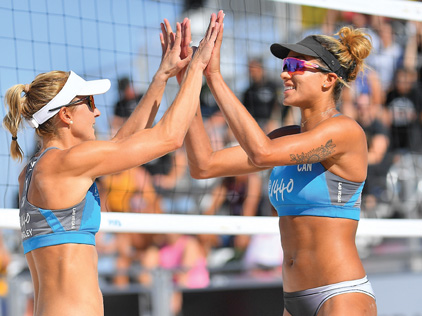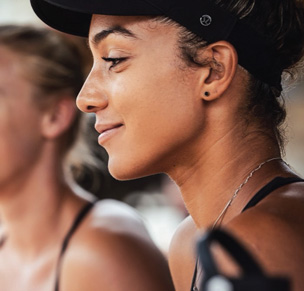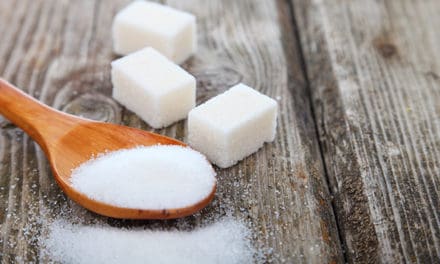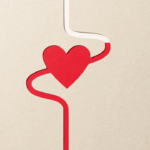
When professional beach volleyball player Brandie Wilkerson was growing up in Toronto, her mother gave her some advice – don’t shy away from challenges; seek them out. The harder they are, the better.
Paul Kvinta, in conversation with Olympian Brandie Wilkerson.
Her mother, Stephanie, lived by these words. Not only were she and her husband immigrants with limited resources raising four kids in a low-income neighborhood, but she somehow made time to train and compete in three Ironman triathlons. For the uninitiated, the Ironman – a 2.4-mi swim, followed by a 112-mi bike ride, then a 26.2-mi run – is widely considered the most gruelling undertaking in sports. “She reminded me of this when I was struggling to balance school, sports, and social life – that challenges are part of life, but I was strong enough to handle them,” Wilkerson says. “So that’s what I try to do. I invite the hard things instead of resisting them.”
This philosophy has vaulted Wilkerson to the top of the beach volleyball world and made her one of the best female athletes on the planet. In 2018, only four years after she first stepped foot on a sand volleyball court, Wilkerson, 29, and fellow Canadian Heather Bansley became the top-ranked team in the world. That same year, Wilkerson was declared the World Tour’s “Best Blocker” for her ability to leap high at the net and neutralize opponents’ incoming spikes. Last year, she and Bansley represented Canada at the Tokyo Olympics, and although they finished in fifth place, they scored a satisfying upset of the gold-medal-contending U.S. team.
The challenges for Wilkerson started early. As a seven-year-old immigrant from Switzerland whose first language wasn’t English, she mostly wanted to fit in and make friends. Engaging in sports was a good way to do this. She played soccer, basketball, rugby, and indoor volleyball. Although her parents had been elite athletes (her mother Stephanie had run for Switzerland; her father Herb had been drafted by the NBA’s Cleveland Cavaliers and played pro basketball in Europe and Asia), they didn’t push their children toward sport careers. Still, the challenge of collegiate-level volleyball intrigued Wilkerson, and she went on to an all-star career at York University in Toronto.
 Beach volleyball was the first sport that didn’t come naturally to Wilkerson, and when she played for the first time while still in college, she found the transition from traditional volleyball extremely difficult. It was a radically different sport. Six-person teams were reduced to two people. The sand dampened Wilkerson’s extraordinary leaping ability. And since she was involved in every play, she was 50 percent to blame when things went wrong. “It challenged me in ways I hadn’t been challenged before,” she says. “With only two on a team, it demands a different level of accountability.”
Beach volleyball was the first sport that didn’t come naturally to Wilkerson, and when she played for the first time while still in college, she found the transition from traditional volleyball extremely difficult. It was a radically different sport. Six-person teams were reduced to two people. The sand dampened Wilkerson’s extraordinary leaping ability. And since she was involved in every play, she was 50 percent to blame when things went wrong. “It challenged me in ways I hadn’t been challenged before,” she says. “With only two on a team, it demands a different level of accountability.”
Little by little, challenge by challenge, Wilkerson became a professional player. She qualified for more events, racked up more top-ten finishes, and upped her prize money. In 2016, Bansley, a pioneer of the sport in Canada, asked Wilkerson to be a training partner for the Olympics in Rio de Janeiro. The following year they became full-time partners, with the 2020 Tokyo Olympics as their ultimate goal. “The Olympics were incredible in many ways,” she says. “First, I had set a goal of just making it to the Olympics, and I accomplished that.” But COVID-19 made the games even more challenging. The Tokyo Olympics were delayed for a year, and when the games finally took place, athletes’ families weren’t allowed to attend. “There was this communal feeling of gratitude to be competing, but of also wanting our families there,” she says. “It was so emotional. In the end, I was proud to give it all I had.”
As it did many people, COVID-19 challenged Wilkerson in interesting new ways. “I realized after the pandemic that I had done a lot of growing,” she says. “I learned that sports are not just about the games and winning. They’re about building character, growing relationships, and being more mature. I now appreciate the process more.”
The cornerstones of Wilkerson’s personal growth are her fitness routine and diet. She wakes up each morning at 7 a.m., has a pre-training breakfast of black coffee and granola with fruit and yogurt, and then works out in the sand for two hours with her partner and everything from playing points to honing skills and running wind sprints. She then has post-training breakfast, typically two or three eggs, beet juice, a slice of bread, and some dried dates or all-natural peanut butter. After a nap, she segues into her afternoon workout, which varies depending on the time of year. Before the start of beach volleyball season, these afternoon sessions focus on building strength and endurance, mainly with heavy weightlifting – squat lifts, deadlifts, and clean lifts – and long interval training on a resistance bike or running in the sand. During the season, from March to October, her afternoon sessions shift to focus on speed, explosiveness, and retaining endurance. These can include jump squats, light lifting, throwing a medicine ball, and sprinting.

Wilkerson’s diet features foods that help her retain strength and recover from physical exertion. “The most important thing is to get carbs and proteins directly after training,” she says. Her go-to favorites include eggs, Greek yogurt, protein shakes, peanut butter, beets, salted coconut water, bananas, and quinoa. After years of being a vegetarian, she recently added fish, primarily salmon, to her diet “for the omega-3s and protein benefits that are hard to find in a purely vegetarian diet.”
Knowing where her food comes from and how it’s grown is as important to Wilkerson as the food itself. “Organic food is so important,” she says. “I want to know that my food is sustainably produced and that it’s as natural as possible. Is it local? How does it get to my table? Eating healthy is less about rules around your diet and more about knowing these things, farm to table.” Insisting on knowing the provenance of her meals adds yet another challenge for a globe-trotting athlete. “I find the easiest way for me to practise this while in other countries is by shopping from local farmers’ markets, which are always plenty, or reading labels at grocery stores about where the food was produced,” she says. “As for dining out, I do a lot of research about different restaurants in the area.”
As glamorous as Wilkerson’s life might seem, the challenges are plenty – the constant travel, the being away from family and friends, the work required to maintain a healthy and environmentally friendly diet. Plus, working out never gets easy. But Wilkerson is built for challenges. “I don’t know how to say this, but it’s hard,” she admits. “Some days, I don’t want to work out. If you’re waiting for easy, it will never come. It’s super hard. But you do it anyway. And then you celebrate that.”
Brandie’s Top Fitness Tips
Whether you’re someone trying to squeeze more exercise into your busy life, or someone who’s never worked out before, Wilkerson offers this nugget: “Understand that none of this is easy or even natural. Know that exercising will come with challenges.” Here are Wilkerson’s tips for helping you stick with it, come what may.
Find Something Interesting
The surest way to stop exercising is to do something you don’t like. If you’re not competitive, don’t join a tennis league. If heights frighten you, avoid climbing gyms. “Do what’s interesting, what feels good, what gives you energy,” Wilkerson says. “And make it your own. If you’re someone who likes being outdoors, do something outdoors. If you’re a nighttime yoga person, do nighttime yoga.”
Build Community
Fitness-wise, few activities can rival running. But running can get lonely. It’s easier to haul yourself out of bed at 5 a.m. for a pre-work three-miler if some fellow runners join you, knowing you’ll all enjoy coffee together at the end. “A community makes it easier,” Wilkerson says. “Don’t exercise in isolation. I’ve tried being a vegan in a house of non-vegans. It’s tough!”
Look Inside
Try not to be influenced by external considerations. Just because everyone is joining a particular gym or hiring a particular trainer isn’t reason enough for you to do the same. “Let it come from inside you,” says Wilkerson. “Be honest about why you’re doing this. When you’re making your goals, think of the worst possible scenario. It’s snowing outside, for example. In that situation, is looking good in a bikini enough to get you to do your workout?”
Brandie’s Post-Workout Shakes
“For retaining strength and recovery, I choose 1 g of carbohydrates per 1 kg (2.2 lb) of body weight to be consumed within a 20-min window post-recovery. It’s vital for me to get carbs and proteins in, directly after training.”
Chocolate PB Shake
- 1 scoop chocolate protein – RealEasy™ vegan or whey
- 1 tbsp all-natural, unsalted, crunchy peanut butter (or almond butter)
- 1 frozen ripe banana
- 1 tsp maca powder
- 1 tsp grounded flax seeds
- A pinch of cinnamon
Blueberry Shake
- 1/2 cup frozen blueberries
- 1/2 cup plain Greek yogurt
- 3/4 cup unsweetened almond milk
- 3 tbsp rolled oats
- 1 heaping tbsp of all-natural, unsalted peanut butter
- 1 tsp honey
- 1/4 vanilla extract
- A pinch of salt
- A pinch of cinnamon












